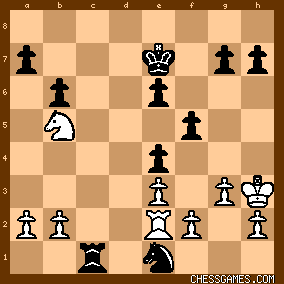| Mar-26-07 | | YouRang: This game is a nice example of how little mistakes can quickly turn your game to crap. After 27...Rc8, we arrive at this position (diagram:white to play):

click for larger view
Black is better, being up a pawn with a more aggressively placed knight and more mobile rook, but there may still be drawing chance for white, and at any rate, with such little material on the board, it at least looks like a long struggle. White should play 28. Kg2, getting the king off the back rank, thus diminishing the threat of ...Rc1+. But white figures, "why bother doing that now, I can always go there AFTER Rc1+". So white opts for the dubious "attack": <28. Nb5?>. But now the black can use check to dictate the timing of white's moves, and this makes all the difference: <28...Rc1!+>, and <29. Kg2> is forced, giving black time for <29...Ne1+! 30. Kh3> (diagram:white to move):

click for larger view
Black answers with <31...Nf3>, threatening to fork and win the rook with ...Ng1+. To avoid this, white went for <31. Kg2?>, and now it's mate: <31...Rg1+ 32. Kh3 g5!> and white is helpless against pawn mate. If 33. g4, then 33....fxg4#, and after any other move, it's ...g4#. White could have improved on 31. Kg2 with 31. Nd4 (guarding the rook and threatening to exchange knights). Black can then win the exchange with 31...Ng1+, but even better might be 31...g5! 32. Nxf3 exf3 33. Rd2, [only safe square for the rook] (diagram:black to move):

click for larger view
And white is still facing mate threats: 33...g4+! 34. Kh4 [forced] Kf6!, and black threatens ...Rh1 and mate on the h-file. White can hold mate at bay a while with 35. Kh5 Rh1 36. h4 gxh3 [en passant], but now nothing will stop the h-pawn from promoting  . . |





